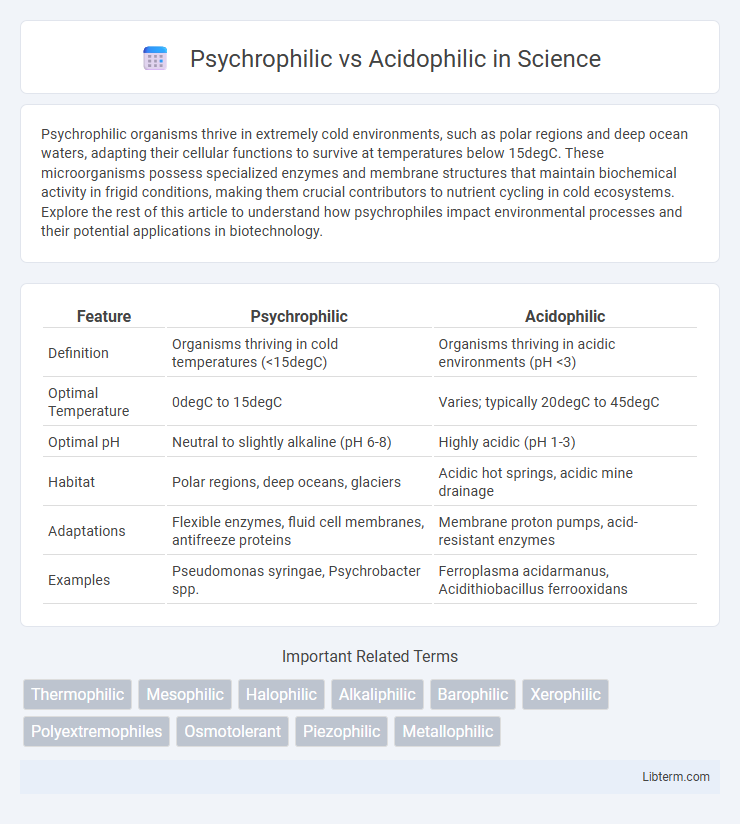Psychrophilic organisms thrive in extremely cold environments, such as polar regions and deep ocean waters, adapting their cellular functions to survive at temperatures below 15degC. These microorganisms possess specialized enzymes and membrane structures that maintain biochemical activity in frigid conditions, making them crucial contributors to nutrient cycling in cold ecosystems. Explore the rest of this article to understand how psychrophiles impact environmental processes and their potential applications in biotechnology.
Table of Comparison
| Feature | Psychrophilic | Acidophilic |
|---|---|---|
| Definition | Organisms thriving in cold temperatures (<15degC) | Organisms thriving in acidic environments (pH <3) |
| Optimal Temperature | 0degC to 15degC | Varies; typically 20degC to 45degC |
| Optimal pH | Neutral to slightly alkaline (pH 6-8) | Highly acidic (pH 1-3) |
| Habitat | Polar regions, deep oceans, glaciers | Acidic hot springs, acidic mine drainage |
| Adaptations | Flexible enzymes, fluid cell membranes, antifreeze proteins | Membrane proton pumps, acid-resistant enzymes |
| Examples | Pseudomonas syringae, Psychrobacter spp. | Ferroplasma acidarmanus, Acidithiobacillus ferrooxidans |
Introduction to Extremophiles
Psychrophilic organisms thrive in extremely cold environments, typically below 15degC, exhibiting specialized enzymes that function optimally at low temperatures. Acidophilic extremophiles inhabit acidic conditions with pH levels often below 3, adapting cellular mechanisms to maintain stability and metabolic activity in high proton concentrations. Both psychrophilic and acidophilic microbes represent key categories of extremophiles, organisms that survive and proliferate in habitats hostile to most life forms.
Defining Psychrophilic and Acidophilic Organisms
Psychrophilic organisms thrive in extremely cold environments, typically below 15degC, with optimal growth at temperatures close to 0-10degC, adapting specialized enzymes and membranes to maintain cellular function in freezing conditions. Acidophilic organisms, on the other hand, are adapted to survive in highly acidic environments, usually at pH values below 3, where they utilize unique acid-stable proteins and mechanisms to maintain intracellular pH homeostasis. Both psychrophilic and acidophilic organisms represent extremophiles with distinct biochemical adaptations allowing survival under temperature and pH stress, respectively.
Environmental Niches and Habitats
Psychrophilic organisms thrive in extreme cold environments such as polar ice caps, deep ocean waters, and alpine glaciers, adapting their cellular functions to temperatures typically below 15degC. Acidophilic microbes inhabit highly acidic environments like sulfuric hot springs, acid mine drainages, and acidic soils, maintaining stability and metabolic activity at pH levels often below 3. Both types exploit specialized niches by evolving biochemical mechanisms that enable survival and growth under these harsh conditions.
Adaptation Mechanisms in Cold vs Acidic Conditions
Psychrophilic organisms adapt to cold environments through the production of antifreeze proteins and maintaining membrane fluidity with unsaturated fatty acids, ensuring enzyme functionality at low temperatures. Acidophilic organisms survive acidic conditions by utilizing proton pumps to expel excess H+ ions and stabilizing intracellular pH with acid-resistant enzymes. These distinct adaptation mechanisms highlight evolutionary specialization in cellular processes to thrive under temperature-related stress versus low pH stress.
Cellular and Molecular Differences
Psychrophilic organisms thrive in cold environments with optimal growth below 15degC, featuring cellular membranes rich in unsaturated fatty acids to maintain fluidity at low temperatures, while acidophilic organisms survive in acidic conditions with pH levels often below 3, possessing specialized proton pumps and highly stable proteins to prevent acid denaturation. Molecular adaptations in psychrophiles include cold-active enzymes with flexible active sites and reduced hydrophobic cores, whereas acidophiles exhibit acid-stable enzymes with increased surface charge and enhanced proton tolerance. These distinct cellular and molecular mechanisms enable psychrophiles and acidophiles to maintain metabolic efficiency and structural integrity under their respective extreme environmental stresses.
Industrial and Biotechnological Applications
Psychrophilic microorganisms thrive at low temperatures, making them ideal for industrial processes requiring energy-efficient biocatalysis, such as cold-enzyme production for detergents and food preservation. Acidophilic microbes excel in low pH environments, enabling their use in bioleaching for metal recovery and bioremediation of acidic waste streams. Both psychrophilic and acidophilic organisms contribute significantly to biotechnology by offering specialized enzymes that function under extreme conditions, expanding the range of sustainable industrial applications.
Challenges in Research and Cultivation
Psychrophilic microorganisms require stable low-temperature environments, posing challenges in maintaining consistent cold conditions for cultivation and experimental reproducibility. Acidophilic species demand highly acidic media with precise pH control, complicating culture maintenance and limiting available growth substrates. Both groups face difficulties in designing optimal growth systems due to their extreme habitat preferences, impacting the scalability and accuracy of research studies.
Impacts on Global Biogeochemical Cycles
Psychrophilic microorganisms thrive in cold environments and play a crucial role in global carbon and nitrogen cycles by decomposing organic matter in polar and deep-sea ecosystems, thereby influencing greenhouse gas emissions. Acidophilic microbes, which survive in low pH conditions, contribute significantly to metal solubilization and nutrient cycling in acidic soils and acid mine drainage areas, impacting sulfur and iron biogeochemical pathways. The metabolic activities of these extremophiles affect the transformation and mobility of key elements, shaping ecosystem functions and biogeochemical feedback mechanisms under varying environmental stresses.
Potential for Astrobiology and Life Beyond Earth
Psychrophilic organisms thrive in extreme cold environments, such as permafrost and icy moons like Europa, making them prime models for understanding potential life in extraterrestrial cryospheres. Acidophilic microbes withstand highly acidic conditions, similar to those found in acidic lakes and hydrothermal vents, offering insights into survival mechanisms on planets with acidic geochemistry like Mars. Studying these extremophiles enhances astrobiological models by revealing biochemical adaptations that support life under hostile extraterrestrial conditions.
Future Directions and Emerging Discoveries
Psychrophilic microorganisms, thriving in subzero to low temperatures, are increasingly studied for their enzymes' applications in biotechnology and sustainable industrial processes under cold conditions. Acidophilic microbes, adapted to highly acidic environments with pH levels often below 3, offer promising opportunities for bioleaching, bioremediation, and understanding extremophile gene regulation. Emerging discoveries focus on molecular mechanisms driving stress tolerance, enabling genetic engineering to enhance microbial efficiency for environmental and commercial use in extreme environments.
Psychrophilic Infographic

 libterm.com
libterm.com